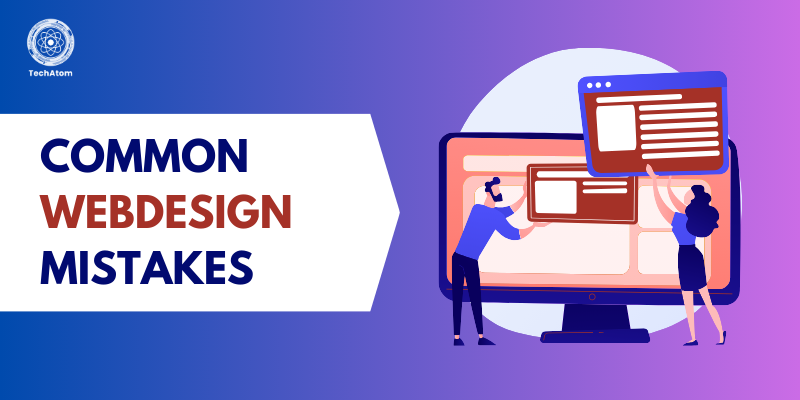Website development is a critical part of any business. A well-upgraded website can do wonders for your organic traffic without any extra hassle. But the challenge lies in the fact that even big-shot players fall prey to faulty designs.
Be it slow loading speed or the lack of research in web development, it can lead to a lot of frustrated users and eventually a loss of traffic regardless of the brand. We at TechAtom know this challenge and how it plagues all of us.
We know web development is a long-term project due to its dynamic nature and needs continuous vigil and upgrades to show signs of improvement. But there are always a few key things that you can keep in mind as you build your business online.
Common Web Development Mistakes
1. Lack of research
Understanding your target audience and their needs is the foundation of effective content, SEO, and your overall online presence. In web development, a lack of research can be a critical mistake, as failing to identify user pain points leads to poor design choices. You must figure out the exact point where you lose your potential clients. You have to rely heavily on market research if you wish to grow your presence. Additionally, it is not enough to just create a design that resonates, but also does a competitor analysis for steady results.
2. Slow Loading Speed
You can risk having mediocre content on your website for a day, but having a slow loading speed will be the end of your legacy. As the competition grows, you always have to be on the tip of your toes and keep your website up and running. Even a few seconds of delay can lead to lower search rankings and lost revenue.
3. Poorly Configured Navigation Layout
A confusing menu or a cluttered layout frustrates users and drives them away. A well-structured website is capable of offering the required information in the easiest way. Your website should have a logical age hierarchy and a purpose behind each demarcation in order to make sense and uphold the integrity of its design.
4. Non-Responsive Web Design
One of the major aspects of search engine optimization is to ensure that the web page is reactive in any setup. If you have a setup that doesn't adapt to various screen sizes, Google is bound to push it down in the rankings. As Google’s mobile-first indexing means that non-responsive websites rank lower in search results.
5. Not Following a Design Thinking Approach
Most web designers tend to sacrifice the basic functionality of the website for aesthetics. The idea of the website is to prioritize user needs and has to be accessible in the real world. You cannot expect your website to hit the target numbers if you are not catering to its usability.
6. Ignoring Cross-Browser Compatibility
It would be a mistake to only test your website against one browser. It would be only a false assumption to build an entire website that varies in browser-specific functionality. Additionally, you have to keep in mind that a website that only works on certain browsers can lose a significant portion of its audience.
7. Overlooking Performance Optimization
As a developer or a business owner, there are certain parameters like website speed and responsiveness that you always have to be mindful about. As you ignore these parameters, you get a website that's slow, unresponsive, and becomes loaded with glitches. You cannot have heavy scripts, codes, or unoptimized images for your website that represent your business.
8. Poorly Structured Code
Search engines prioritize clean, well-organized code for indexing, ensuring better rankings and a smoother user experience. A poorly structured HTML or CSS can slow down your performance and even crash your entire setup.
Best Web Development Practices for a High-Performing Website
If you do a quick search, you will see that almost every website says that more than 60% of the people abandon a slow loading website. As an online business, you should consider this as a warning sign.
No matter what happens, you cannot afford to let a user go without seeing your content. As in online browsing, first impression is always usually the permanent one. You have to make sure that your website is SEO-friendly design and is highly optimized for your users.
- You have to be aggressive with your research and include Google Analytics, customer surveys in the conversation. The idea is to analyze your user behavior and create a demand. Additionally, a thorough check on your competitors offerings is a great idea too.
- The next step would be to optimize all the loose ends like your images, broken links, ensuring there is proper navigational direction in your pages and so much more.
- Keep menus simple, intuitive, and structured to improve user engagement. Upgrading your website doesn't necessarily mean you have to overcomplicate your offerings.
- Taking care of the mobile friendliness of your design is another important aspect of this conversation. A responsive design ensures your site adapts seamlessly to different screen sizes, improving user experience, engagement, and SEO rankings. You can rely on Google’s Mobile-Friendly Test or use responsive frameworks.
- Follow clean coding practices with properly indented and documented code and remove redundancy wherever possible.
Conclusion
Your website is often the first impression potential customers have of your brand, and any flaws in can ruin your reputation forever. Avoiding common web development mistakes and following best practices ensures your site remains fast, user-friendly, and SEO-optimized.
At TechAtom, we understand the challenges businesses face in web development. That’s why we are committed to providing insights and solutions to help you build a high-performing website that drives traffic and conversions. Stay ahead of the competition by letting us do one of the many things that we do best.
People are also reading:
- Top Web Development Technologies
- How to Become a DevOps Engineer?
- Growth Hacking Strategies
- Common Mobile App Design Mistakes
- Agile Project Management Tools
Frequently Asked Questions
1. How does slow loading speed affect website performance and visitor engagement?
A slow loading website is frustrating that leads to potential users abandoning it midway. It also reduces conversion rates, as users are less likely to complete actions like making a purchase or signing up if the website doesnt load.
2. Why is responsive web design important for mobile users?
The thing is, Google ranks mobile friendly websites higher, leading to an increase in your overall reach. A responsive design ensures that content adjusts smoothly across different screen sizes, leading to enhanced engagement.
3. What strategies can be used to avoid vague messaging on a website?
Vague messaging can lead a usee to abandon your website forever and also weaken your hold as a brand. You need to be clear and authoritative about your instructions and guide any visitor seamlessly though your website. All you have to do is use simple language while you call or action.
4. How does a cluttered interface affect user engagement, and how can it be improved?
A cluttered interface overwhelms users, making navigation difficult. You have to ensure that too many elements shouldn't distract your users from the main message. Sticking to consistent patterns, limiting the number of fonts and decluttering the elements are some of the few measures you can follow.
5. What is the ideal font size for different devices to ensure readability?
The ideal font size varies across devices if you wish to follow the best practices you can opt for:
- Desktop: 16–18px for body text, 24–32px for headings.
- Tablets: 14–16px for body text, 22–28px for headings.
- Mobile: 14–16px for body text, 18–24px for headings.
6. How can businesses define their target audience for better website design?
As you get to know your audience better you will be able to build a platform that attracts more conversions. The ideal way to know your audience is to conduct market research, understand your demographic and rely on Google Analytics, A/B Testing and address the pain points.
7. Why is hidden navigation a problem, and how can it be fixed?
Hidden navigation takes the focus away from your main menu and hides the important navigational features behind icons or buttons. This can be a catastrophe as it might frustrate your existing customer base and any potential client greatly. You have to keep the main navigation visible on desktop and never overwhelm your users with multiple options.
8. What are the benefits of a custom 404-page design, and how can it improve user experience?
A generic 404 page frustrates visitors and confuses them. But if you put in some effort in designing your 404 it leaves a long-lasting impression on the user as it reduces the agony instantly. Any funny message or an engaging visual with a friendly undertone can really help put your point across.




